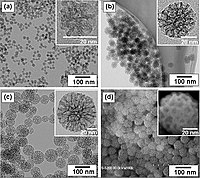
Photo from wikipedia
Plasmonic particle arrays have remarkable optical properties originating from their collective behavior, which results in resonances with narrow line widths and enhanced electric fields extending far into the surrounding medium.… Click to show full abstract
Plasmonic particle arrays have remarkable optical properties originating from their collective behavior, which results in resonances with narrow line widths and enhanced electric fields extending far into the surrounding medium. Such resonances can be exploited for applications in strong light-matter coupling, sensing, light harvesting, nonlinear nanophotonics, lasing, and solid-state lighting. However, as the lattice constants associated with plasmonic particle arrays are on the order of their resonance wavelengths, mapping the interaction between point dipoles and plasmonic particle arrays cannot be done with diffraction-limited methods. Here, we map the enhanced emission of single fluorescent molecules coupled to a plasmonic particle array with ∼20 nm in-plane resolution by using stochastic super-resolution microscopy. We find that extended lattice resonances have minimal influence on the spontaneous decay rate of an emitter but instead can be exploited to enhance the outcoupling and directivity of the emission. Our results can guide the rational design of future optical devices based on plasmonic particle arrays.
Journal Title: ACS nano
Year Published: 2019
Link to full text (if available)
Share on Social Media: Sign Up to like & get
recommendations!